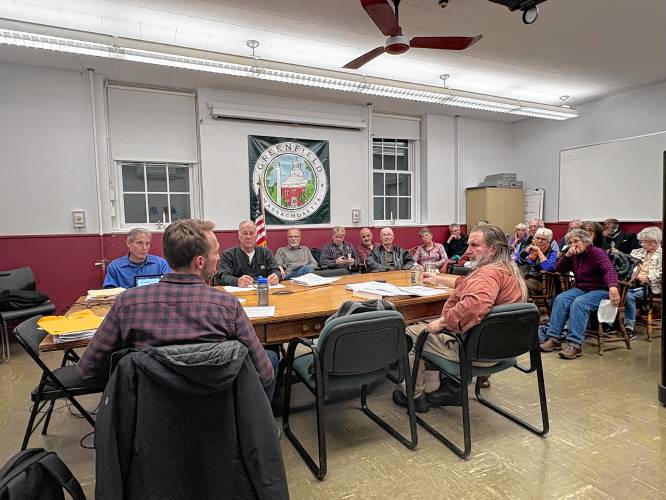Greenfield Planning Board recommends nixing housing unit cap, updating ADU bylaws

Planning Board members deliberate on Thursday over a series of proposed housing ordinance amendments that intend to facilitate more dense housing development in Greenfield. STAFF PHOTO/ANTHONY CAMMALLERI
| Published: 12-09-2024 4:19 PM |
GREENFIELD — The Planning Board is recommending a pair of zoning ordinance amendments that, if passed by City Council, would bring the city’s accessory dwelling unit (ADU) bylaws in line with a new state law and eliminate the cap on the number of units allowed in new housing developments.
In a more than three-hour meeting on Thursday evening, the board also voted to recommend that the city work to determine the number of units developers should be allowed to build on a new multi-family housing structure; and, with a vote tied with two in favor and two abstentions, withheld action on a proposed ordinance that would allow the construction of medical clinics and hospitals by right in the Central Commercial District.
The ordinances were part of a five-part housing package that was first introduced by At-Large City Councilor John Garrett. On Nov. 20, City Council voted in favor of one of the five ordinances, thus legalizing the construction of first-floor residential units in mixed-use complexes.
Among the most controversial zoning amendments was the one concerning the construction of ADUs by right throughout the city.
While Garrett’s original proposal calling for relaxed restrictions on the construction of ADUs was superseded by Gov. Maura Healey’s August passage of the Affordable Homes Act, which allows for the construction of ADUs by right throughout the state, housing activists Al Norman, Mitchell Speight and Joan Marie Jackson filed a citizen’s petition calling for an ordinance that would effectively restrict the construction of ADUs to parcels that are 0.5 acres or larger and that consist of at least 50% open space. The citizen’s petition proposal would also ban the use of ADUs for short-term rentals such as Airbnb or Vrbo.
Although Garrett removed his ADU ordinance from the package after the Affordable Homes Act passed, City Council sent the citizen’s petition back to the Planning Board on Nov. 20, and tasking Planning Director Eric Twarog with re-writing the proposed ordinance to bring it into compliance with the new state law.
“The ordinance I wrote up that is currently before you for consideration did include one provision from the citizen’s petition, which is a prohibition on short-term rentals for ADUs — I believe that was a good idea,” Twarog said. “But the language I put forth, the purpose of it is to meet the new law and that’s all.”
The Planning Board’s discussions, which were attended by roughly 30 members of the public — approximately 10 of whom carried signs reading “Bye Bye to By Right” — prompted controversy. The majority of those who spoke on the issue argued that the board should wait until the state releases guidelines on how municipalities should regulate the law before voting to approve an ordinance.
Article continues after...
Yesterday's Most Read Articles
In the board’s deliberations on whether to hold off on voting to recommend Twarog’s ordinance, Vice Chair Jeff Sauser noted that ADU construction regulations cannot be more relaxed than those that restrict additions onto homes. Currently, Sauser explained, added construction on a home, such as a new garage, requires that the lot have at least 40% open space — only 10% less than suggested in the citizen’s petition.
Still, Planning Board member Victor Moschella pointed out that the city’s current ADU regulations, which require a special permit for the construction of a detached ADU, do not comply with the new state law. While additional restrictions can be placed on ADU construction once the state publishes its local guidelines, he said the city has a duty to be in compliance with the Affordable Homes Act, which takes effect on Feb. 2.
“We have an ordinance that we’ve adopted and modified that’s compliant with the state as it currently is. There’s nothing that says that if the state comes back to change their guidelines, we can’t change our ordinance,” Moschella said. “This is the law of the land, so we move forward with the law of the land. Until the law changes, we abide by the law.”
The Planning Board voted unanimously to recommend the amended ADU ordinance to City Council.
The board also voted 3-0 with one abstention to recommend an amendment to the city’s zoning ordinances to remove restrictions on the number of units that can be built in new housing developments.
Currently, new multi-family dwellings in Greenfield are restricted to 24 units. They must also comply with a 40% open space requirement and zone-specific setback and height requirements. If approved by City Council, Garrett clarified, the original amendment would not alter dimensional or open space restrictions, but would merely eliminate the 24-unit limit, allowing for more dense housing production.
“It removes an arbitrary cap on the number of units in a building,” Garrett explained. “The box size does not change if we’re thinking about an apartment or a row house full of condos, but the way that it’s subdivided does.”
Moschella noted that given Greenfield’s position as the “hub of Franklin County,” the elimination of unit restrictions on housing development could serve as an economic catalyst, incentivizing developers to build more profitable units while driving housing production to create homes for those who wish to move to the city.
Similar to the ADU bylaw changes, removal of the 24-unit cap came with some public opposition from residents such as Christopher Ethier, who argued that without limitations on the number of units that could be constructed in a multi-family complex, large developers can build structures that can significantly change the “nature of” downtown Greenfield.
Ethier also feared that not having a requirement necessitating that developers to come to the Planning Board for a special permit would deny abutters a chance to weigh in on future developments.
“If you have something like 24 units, and somebody comes in and says, ‘Look, this place could really take 70 units,’ they would come to you and talk about it again [through] special permits,” Ethier said. “I thought that’s what special permits were for.”
Noting that a major development review, a long and costly process for studying a development’s impact on the greater environment, is required for housing developments with more than 50 units, Sauser suggested a compromise ordinance in which smaller multi-family developments can be legally built by right and larger developments require a special permit.
Sauser also noted that City Council can determine the number of units at which a development should require a special permit after further research goes into the pending amendment.
“There’s all these other rules that make it so you can’t build to the moon. But there are a couple of sites that are being discussed that can accommodate more units, and those are the ones that concern people,” Sauser said. “We shouldn’t hold back on the smaller projects that we also need that aren’t impacting people in a big way for the sake of controlling a couple of parcels that probably do deserve a bigger community conversation.”
After Planning Board Chair George Touloumtzis motioned not to recommend a proposed zoning amendment that would allow medical facilities and clinics to operate by right in the city’s Central Commercial District, Sauser and board member Peter McIver both abstained from the vote, while Moschella seconded Touloumtzis’ motion. Without three votes either for or against the motion, no recommendation could be made.
Twarog explained the amendment was first proposed when city officials discovered that the city houses a number of medical facilities downtown that do not have a special permit, and are therefore not in compliance with the city’s existing ordinances. He noted that the proposed amendment would bring the city’s clinics into compliance.
Moschella said he does not support the amendment as he does not like some of the existing medical facilities and he believes a special permit should be required for anyone who wants to open a new one.
“I’d like to see downtown become a commercial center for people to shop and walk and eat and drink and have a good time, and not become a medical facility hub,” Moschella said. “We’ve already got half a dozen clinics. There’s a couple in there that I really don’t like, but there’s one or two down the street from the ice cream parlor. I don’t want to see more of that in our town.”
Anthony Cammalleri can be reached at acammalleri@recorder.com or 413-930-4429.






 ‘It’s a Wonderful Night in Turners Falls’ showcases village businesses, nonprofits
‘It’s a Wonderful Night in Turners Falls’ showcases village businesses, nonprofits Sackrey Construction Co. of Sunderland celebrating 35 years in business
Sackrey Construction Co. of Sunderland celebrating 35 years in business Photo: As darkness falls
Photo: As darkness falls Leverett residents rap Kittredge compound plans, urge caution as negotiations for 400 homes move forward
Leverett residents rap Kittredge compound plans, urge caution as negotiations for 400 homes move forward 
